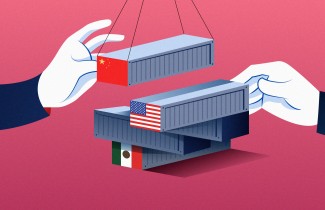Nearshoring in Mexico: Blessing or Curse (or Both)?
Exposing the contradictions of Nearshoring in Mexico

As the well-known saying goes, ‘in the midst of every crisis, lies great opportunity.’ The Covid-19 pandemic, together with various geopolitical and economic factors, generated an unprecedented window of opportunity for Mexico's growth, manifested in the nearshoring phenomenon.
Essentially, nearshoring implies relocating productive and service chains towards places close to the FDI countries of origin. With respect to Mexico, data from the Inter-American Development Bank and ManpowerGroup LATAM predict that this trend will result in exports totaling more than 35 billion dollars, the creation of between one and 3.5 million new sources of employment, and a significant acceleration in infrastructure development.
At first glance, with this optimistic panorama, nearshoring can be perceived as a ‘blessing’ for Mexico. However, it’s not as simple as that, especially if we visualize this phenomenon from a long-term perspective.
In fact, nearshoring could possibly become a ‘curse’ for Mexico that perpetuates the status quo, distancing us even further from the country’s potential as a generator of new high value-added knowledge. Part of this challenge lies in a set of contradictions in which the country is immersed, as listed below.
Contradiction 1: Disparity between economic growth and performance in science, technology and innovation (STI)
Despite Mexico’s remarkable economic growth since its trade liberalization in the early 1990s, the country is far behind in its STI performance worldwide. Compared to the OECD country average, Mexico’s investment in STI, in relation to its respective Gross Domestic Product (GDP), is eight times lower (0.31% vs. 2.38%); the number of researchers per 1,000 of the total personnel employed, nine times lower (1.0 vs. 8.6); and the percentage of patent applications by residents, six times lower (9.5% vs. 60.1%). These figures have relegated Mexico to 58th place in the ‘Global Innovation Index 2023’, the innovation and competitiveness ranking, which is a long way from its position in the World Economy list, where our country is ranked 12th, based on its GDP, for that same year.
Contradiction 2: The Government leads investment in STI in Mexico, while in developed countries it is the business sector
Unlike developed countries, where the business sector leads investment in STI with two thirds of the total amount, in Mexico this responsibility falls mainly on the government, which contributes three quarters of the total investment. This situation raises questions about the reasons why companies in Mexico do not invest in innovation. According to Jaime Parada Ávila, former director of Conacyt and former president of the Academy of Engineering, factors such as the low level of maturity and competitiveness of companies, their short-term focus, the lack of financial metrics for innovation, the absence of a systematic model for innovation, and the need for greater government motivations and incentives for business innovation contribute to this discrepancy.
Contradiction 3: We have the capacity to generate diversity and complexity, but based on outside knowledge
When considering the complexity index defined by the Growth Lab at Harvard University, Mexico comes 20th among 133 different countries. This position reflects a not inconsiderable performance! It means that our country is capable of generating products as complex as aerospace items, cars, electronic components and medical equipment, something that only a handful of countries can do. However, this apparent strength is misleading when we analyze the domestic added value produced by our country in these technologies, which, according to data from INEGI, does not exceed 25% in complex products. In short: we manufacture and assemble, that is, we make, but do not create or design or develop these complex products. Therefore, we can see that Mexico is stuck in the center of the ‘smiling’ curve, which describes the creation of added value across production chains, far from the ends of the curve where the largest margins, such as brand design and service, are concentrated. Instead of being proud of ‘made in Mexico,’ we should get excited about ‘designed in Mexico,’ reflected in companies that have jumped the curve towards greater domestic added value.
Contradiction 4: We want to meet complex needs without having the basics
The Maslow Pyramid establishes a hierarchical model of human needs, where the fulfillment of more complex needs (such as self-actualization) depends on the satisfaction of basic aspects, including physiology, security, affiliation and recognition. This analogy can be extrapolated to the national level. In Mexico, we long to develop high added-value domestic competencies based on STI, since, according to Juan Enriquez Cabot, these competencies allow the disproportionate generation of value. This phenomenon can be seen in the cases of Tesla and Apple, for example, as their market values exceed the GDP of countries such as Mexico. However, we are immersed in the search for STI efforts without having yet addressed basic aspects such as violence and insecurity, deficient education, and the persistent problems of a lack of democracy and justice that afflict our country.
Contradiction 5: Mexico has the important factors to attract companies, but they are concentrated in just some states
The important factors for attracting companies, such as skilled labor, quality infrastructure, resources required by specific companies (such as water, energy, or gas), relatively simple incorporation into productive clusters, access to distribution chains, closeness to the target market, access to research centers, etc., are concentrated in just some states, and, therefore, not everyone will enjoy the same direct (and indirect) impact of nearshoring.
Contradiction 6: Despite everything, we do have success cases
The innovation ecosystem comprises a group of agents that interact for the creation, use and dissemination of innovation. Although the current outlook for Mexico’s innovation ecosystem presents significant challenges, there are several examples of companies that have managed to overcome these barriers and move towards the generation of greater added-value knowledge, thereby jumping the “smiling” curve. Examples of companies such as Rassini, Orbia, and Kio Networks, among others, can be compared to bacteria capable of surviving in extremely adverse conditions in deep-sea vents. In our case, they have demonstrated the capacity to resist in a challenging innovation ecosystem, such as Mexico's.
These contradictions could, of course, lead us to maintain the status quo, where Mexico continues to be labeled as a country with cheap labor, thus perpetuating the ‘curse.’ Breaking away from these contradictions would bring us closer to a ‘blessing’ scenario, in which nearshoring generates opportunities for greater value-added knowledge in the medium and long terms, by means of more complex knowledge spillovers, including the creation of research and development centers. An example of success is the Intel Design Center in Zapopan (Jalisco), whose teams of Mexican researchers have developed hundreds of patents.
Of course, the generation of new knowledge is only one of several aspects that must be considered in order to achieve an economically and environmentally sustainable, inclusive and equitable future for our country.
The authors are research professor at EGADE Business School (Alfonso Ávila Robinson), adjunct professor at the School of Engineering and Science (Gustavo Alberto Berretta González) and research professor at School of Engineering and Science (David Güemes Castorena).



